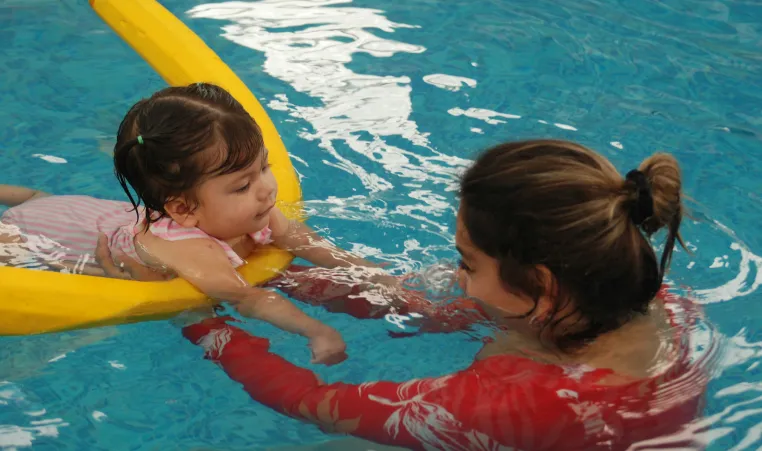
Over the years, the Y has taught millions of people how to safely navigate the water. Water safety is a cornerstone of our mission to build safer communities. In this blog, we’ll explore why water safety matters, what the Y is doing to make a difference and how you and your family can dive into safer habits this summer.
1. Why Water Safety Matters
Drowning is the fourth leading cause of accidental death in children ages 1 to 4 and remains a concern for families across the country. However, with education, supervision and swim instruction, many of these tragedies are preventable. With swim lessons starting at just 6 months old, it’s never too early to start teaching your children about water safety.
At the Y, we believe every child deserves access to water safety education no matter their background or skill level. By equipping kids with the tools to stay safe, we’re not only preventing accidents, we're building lifelong confidence in and around water.
When kids have the skills to save themselves in the water, they also feel more confident and comfortable in the water. They are ready to jump off the high dive, cruise down any slide and cannonball into the deep end — safely!
2. The Y’s Role in Promoting Water Safety
The Y has been a leader in aquatic safety for more than 100 years. From preschoolers learning to float to teens becoming certified Lifeguards, our programs are designed to meet every swimmer at their level.
Our water safety programs include:
- Progressive swim lessons for all ages and abilities
- Lifeguard and CPR certifications
- Parent-child swim classes
- Safety Around Water free water safety courses for underserved youth
Our trained instructors focus on both skills and safety, helping families feel confident in and around the water.
3. Tips for Staying Safe Around Water
Whether you’re heading to the pool, lake or ocean, remember these key safety tips:
- Always supervise children. Even if they know how to swim, the risk of drowning is high. With the majority of child drownings happening outside of swim times, it’s essential to always have an eye on your children when they’re in the water. If you are with a group people, have the adults take turns being the designated water watcher.
- Wear life jackets. If your child isn’t confident in the water, life jackets are a great way to give you some peace of mind while allowing them to practice and improve their water skills.
- Keep your children educated. Safety starts with awareness. Being aware of the risks involved with swimming and providing the knowledge required to be safe is the best way to prevent drownings.
- Know the environment. Whether you’re swimming in a pool, lake, river or ocean, always be aware of your environment. Keep note of lifeguard stations, exits, currents, drop-offs and weather changes.
- Learn CPR and first-aid: In the event of an emergency, CPR can save lives. Proper training can increase chances of survival by 91% in the event of a drowning.
- Dress for safety: Making sure you can keep an eye on your kiddo at a busy pool can be a challenge. Dress them in bright colors that you can spot in and out of the water. Red, neon orange and bright pink are also easier for Lifeguards to see underwater.
4. Water Safety at Home
Water safety doesn’t stop at the pool. There are plenty of ways you can practice caution and continue education at home.
- Empty kiddie pools, buckets and tubs. Although it may seem like an insignificant amount of water, an estimated 25% of drownings occur in three feet of water or less.
- Install proper barriers and alarms for home pools or hot tubs. Over 70% of child drownings happen during “non-swim times,” highlighting the importance of keeping your pool secure and inaccessible. Installing a four-sided barrier around your pool can reduce the risk of drowning by 83%.
- Teach and reinforce safe water behaviors year-round. While swimming may seem like a summertime activity, it’s important to continue water safety training year-round. Just like any other skill, you can’t expect your children to retain water safety skills if they are only being taught and practiced a few months out of the year.
6. How to Get Involved
- Share safety tips. When it comes to water safety, knowledge is power. Sharing tips on social media or with friends and family is an excellent way to keep your community safe, educated and aware of the risks involved.
- Donate. Every year, the Y provides scholarships and financial assistance to hundreds of families. One in three Y members and participants are able to access Y offerings because of financial assistance. Your donation can help fund swim lesson scholarships for underserved youth. Your support could help save a life.
Water safety saves lives. At the Y, it’s at the heart of everything we do. We invite you to take part by learning, sharing, and practicing safe habits around water.
Whether it’s enrolling in swim lessons, attending a family event, or simply spreading awareness, every step helps create a safer summer for all.
Sign up for swim lessons today online or at your local Y.